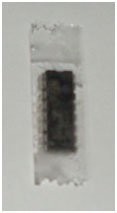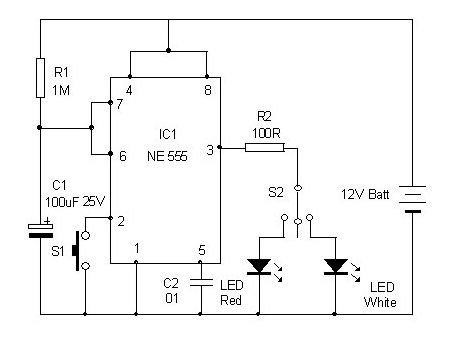Here is a dual colour lamp to read the code printed on the Transistors and ICs. The code and number printed on the black coloured body of these components are difficult to read if the room light is low since the printing is in faint colour or as impressions. This LED lamp is useful to identify the components easily.
The circuit is a simple Monostable timer using NE555. With the timing components R1 and C1, the output of IC1 turns on and remains high for 2 minutes when S1 is pressed and released. Selector switch S2 is used to light either Red orWhite LED since some printing on the IC is more clear in Red light. Use a 12 volt mini battery like the one used in Car remote. If you have a Magnifier, attach the same to the unit.
A Trick
If the code printed on the IC or transistor is faded or not clear, this trick will help you to identify the code. Clean the surface of the component. Take a small piece of Cellotapeand paste it over the printed side of the component. Then remove the Cellotape. The printing will be clear to read. Try it and see the result.

Coding in components
Semiconductor devices are coded and the codes represent, the semiconductor used, its function, code of manufacturer etc.
Transistor coding
Information for a particular transistor is shown as a code on the body of the transistor. According to the European system of coding, there are two alphabets before the number. First alphabet represents the type of semiconductor used and the second alphabet represents the use of transistor.
First letter
A – Germanium
B – Silicon
C – Gallium Arsenide
D – Indium Antimide
Second letter
C – Audio frequency Amplifier
D – Audio frequency power amplifier
F – Low power Radio frequency amplifier
P – High power Radio frequency amplifier
Thus the transistor BC548 is B – Silicon C- Audio frequency amplifier, BD 140 – B – Silicon, D- Audio frequency power amplifier, AD 140 – A – Germanium, D- Audio frequency power amplifier, AC 187 – A- Germanium, C- Audio frequency amplifier etc( Not obsolete, still available in the market).
According to the American system, the code begins with 2N followed by a number that indicates the time of design. A higher number indicates recent design. Eg. 2N 2222A
Capacitor Coding
Electrolytic capacitors have value printed on its body. Pins can be easily identified. Large pin is positive. Moreover a black band is printed near the negative terminal to identify the polarity. In Disc capacitors, only a number is printed on its body so it is very difficult to determine its value in PF, KPF, uF, n etc. In some capacitor, its value is printed in uF eg.0.1 in some others EIA code is used e.g. 104. Let see the capacitor identification.
1. One or two numbers on the capacitor represents value in PF e.g. 8 = 8PF
2. If the third number is zero, then the value is in P e.g. 100 = 100PF
3. If the capacitor has three numbers and the third number is not a zero, it represents the number of zeros after the first and second digits e.g. 104 = 10 – 0000 PF
4. If the value is obtained in PF, it is easy to convert it into KPF or uF
PF / 1000 = KPF or n , PF / 10, 00000 = uF
For example, if the capacitor is 104, then it is 10-0000 PF or 100 KPF or n or 0.1 uF
Conversion formula
n x 1000 = PF PF/1000 = n
PF/1,000,000 = uF
uF x 1,000,000 = PF
uF x 1,000,000/1000 = n
n=1/1,000,000,000F
uF = 1/ 1000,000 F
English letter below the value represents tolerance e.g. 473 = 473 K
If the capacitor has four digits and the fourth digit is a zero, then the value is in PF. E.g. 1500 = 1500PF
If a number is represented with a decimal, the value is in uF. E.g. 0.1 = 0.1 uF
If an alphabet is given below the digits, it represents a decimal and the value is in KPF or n E.g. 2K2 = 2.2 KPF
If the values are given with slashes, the first digit represents value in UF, second its tolerance and third its maximum voltage rating E.g. 0.1/5/800 = 0.1 uF / 5 % / 800 Volt.
Circuit Diagrams
Filed Under: Electronic Projects



Questions related to this article?
👉Ask and discuss on EDAboard.com and Electro-Tech-Online.com forums.
Tell Us What You Think!!
You must be logged in to post a comment.